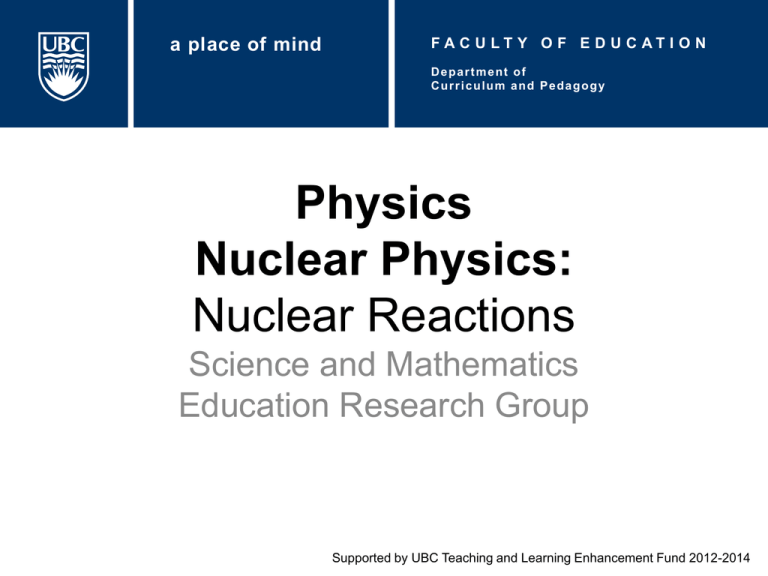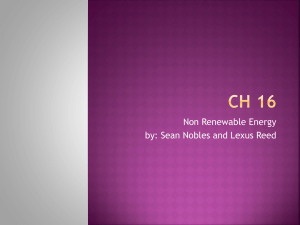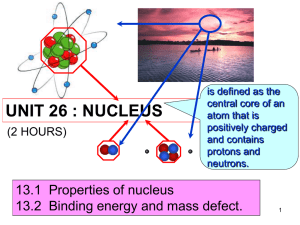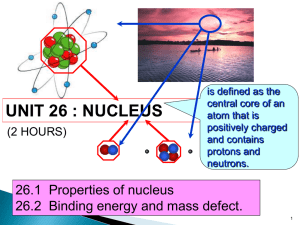Nuclear fission
advertisement

a place of mind FA C U LT Y O F E D U C AT I O N Department of Curriculum and Pedagogy Physics Nuclear Physics: Nuclear Reactions Science and Mathematics Education Research Group Supported by UBC Teaching and Learning Enhancement Fund 2012-2014 Fission and Fusion Reactions Nuclear Reactions I Nuclear fusion occurs when two or more lighter nuclei join together to form a new heavier nucleus. Nuclear fission occurs when a heavy nucleus splits into lighter nuclei. What type of reaction is shown below? 235 92 U 1 0 n 98 40 A. Nuclear fusion B. Nuclear fission C. Neither A or B Zr 135 52 Te 3 0 n 1 Solution Answer: B Justification: The nuclear reaction is a fission reaction. 235 92 U 1 0 n 98 40 Zr 135 52 Te 3 0 n 1 An uranium-235 nucleus splits into two lighter nuclei, zirconium-98 and tellurium-135. This fission reaction is induced because it relies on the presence of a neutron to form a highly unstable isotope. The reaction can be more accurately described as a two-step process: 235 92 U 236 92 n 236 92 U 98 40 1 0 U (unstable) Zr 135 52 Te 3 0 n 1 Nuclear Reactions II Another common induced fission reaction of uranium-235 is shown below, where X is an unknown isotope. What is the unknown isotope X? 235 92 U 1 0 n A. 89 36 Ac B. 90 36 Th C. 89 36 Kr D. 90 36 Kr E. 92 36 Kr 144 56 Ba X 3 0 n 1 Hint: Isotopes are labelled A → mass number Z → atomic number E → element symbol Press for hint A Z E Solution Answer: C 235 92 U 1 0 n 144 56 Ba 89 36 Kr 3 0 n 1 Justification: The number of protons and neutrons in the nuclear reaction must be conserved. There are 92 protons (the atomic number of uranium) on the left side of the equation, so isotope X must contain 92 – 56 = 36 protons. This corresponds to the element krypton (Kr). We can use the mass numbers of the reactants and products to determine the mass number of X. This will ensure that the neutrons are conserved: 235 1 144 x 3 (1) x 89 89 The isotope is therefore 36 Kr . 89Kr contains 36 protons and therefore 53 neutrons, for a total of 89 nucleons. Nuclear Reactions III Consider the following nuclear fission reaction: 235 92 U 1 0 n 144 56 Ba 89 36 Kr 3 0 n 1 Binding Energy Per Nucleon (MeV) Which side of the reaction will have more mass? 10 89Kr 8 A. Left side 144Ba 235U 6 B. Right side 4 C. Both sides have the same mass 2 0 0 40 80 120 160 Mass Number, A 200 240 Solution Answer: A Justification: From the binding energy curve, we can find that both 144Ba and 89Kr have a higher binding energy per nucleon than 235U. The lower binding energy per nucleon of 235U means that it has less mass defect per nucleon compared to 144Ba and 89Kr. E binding m defect c 2 Since the number of nucleons is conserved in the reaction, should be heavier than the products. 235U Likewise, 144Ba and 89Kr have more binding energy per nucleon and therefore have larger mass defect per nucleon. We can expect 144Ba and 89Kr to have less mass (due to more mass defect) than 235U. Answer continues on the next slide Solution Continued Answer: A Justification: We can find the atomic mass of each isotope in data tables and calculate the mass of each side of the reaction: m U m n 235 . 0439 u 1 . 0087 u 236 . 0526 u m Ba m Kr 3 m n 143 . 9229 u 88 . 9176 u 3 1.0087 u 235 . 8666 As predicted, the original uranium has more mass than its fission products by 0.1860 u. Nuclear Reactions IV Consider the following nuclear fission reaction: 235 92 U 1 0 n 144 56 Ba 89 36 Kr 3 0 n 1 Is the reaction endothermic or exothermic? Recall that the left side of the equation has more mass than the right side. A. Exothermic B. Endothermic C. Energy is not involved in the reaction Solution Answer: A Justification: The reaction is exothermic, which means that energy is released as a product in the reaction. Mass and energy must be conserved in the nuclear reaction. Since the left side of the reaction has more mass, mass must have been converted into energy. When the large uranium atom splits into smaller nuclei of less mass, energy is released. Most of this energy is in the form of kinetic energy of the particles. You may recall that the amount of energy released is equal to: E mdc 2 where md is the mass defect of the reaction, and c is the speed of light. Nuclear Reactions V 235 92 U 1 0 n 144 56 Ba 89 36 Kr 3 0 n 1 We found that the difference in mass between the products and reactants is 0.1860 u (or 3.0885 × 10-28 kg). How much energy is released when a single uranium nucleus splits? A. 4 . 447 10 36 B. 2 . 776 10 11 C. 5 . 780 10 7 D. 173 . 5 MeV E. 1 . 733 10 MeV MeV MeV E mc MeV c 2 . 9979 10 m/s 2 8 1 u 931.5 MeV 8 Press for hint Solution Answer: D Justification: If we apply the formula E = mc2, mass must be given in terms of kg so that the formula returns the units joules. E mc 2 ( 3 . 0885 10 2 . 7758 10 28 11 kg )( 2 . 9979 10 m/s ) 8 2 J It is common to convert this into units of megaelectron volts (MeV) using the following conversions: 2 . 7758 10 11 J 1 eV 1 . 602 10 19 J 1 eV 6 173 . 3 MeV 10 eV For a single reaction, this is a lot of energy. Alternative Solution Answer: D Justification: Some students may recall that 1 u is equivalent to 931.5 MeV. This can be found by repeating the steps in the previous slide, except finding the energy equivalent of 1 u = 1.6605 x 10-27 kg. Using this conversion, we can quickly find the answer we obtained previously: 0 . 1860 u 931.5 MeV 1u 173 . 3 MeV Nuclear Reactions VI Nuclear fusion occurs when two or more lighter nuclei join together to form a new heavier nucleus. Nuclear fission occurs when a heavy nucleus splits into lighter nuclei. What type of reaction is shown below? 2 1 D 1T 3 4 2 He 1 0 n Note: 2 1 A. Nuclear fusion B. Nuclear fission C. Neither A or B 2 D is equivalent to 1 H . 3 1 3 T is equivalent to 1 H . Solution Answer: A Justification: The nuclear reaction is a fusion reaction. 2 1 D 1T 3 4 2 He 1 0 n In this reaction, deuterium (hydrogen with 1 neutron) and tritium (hydrogen with 2 neutrons) fuse together to form a heavier helium nucleus along with a neutron. Nuclear Reactions VII Which side of the reaction will have less mass? 2 1 D 1T 3 4 2 He 1 0 n Binding Energy Per Nucleon (MeV) Review question 3 if needed. 10 8 A. Left side 4He 6 B. Right side 4 C. Both sides have the same mass 3T 2 2D 0 0 40 80 120 160 Mass Number, A 200 240 Solution Answer: B Justification: From the binding energy curve, we can conclude that 4He has a much larger binding energy per nucleon than both deuterium and tritium. Since nucleons are conserved in reactions, 4He must also have more mass defect per nucleon than deuterium and tritium, so we should expect 4He to have less mass. m D m T 2 . 014102 u 3 . 016049 u 5 . 030151 u m He m n 4 . 002603 u 1.0087 u 5 . 011303 u Notice how in both fusion and fission reactions, the reaction products have less mass and so the reactions release energy. Multiplying the mass defect by 931.5 MeV / u shows that this reaction releases about 17.6 MeV of energy. Nuclear Reactions VIII 2 1 D 1T 3 4 2 He 1 0 n In order for deuterium and tritium to fuse together, the two nuclei must be brought close together. This does not often occur naturally due to electrostatic forces keeping the nuclei apart. Under what conditions might deuterium and tritium undergo nuclear fusion? A. Many free neutrons to trigger a reaction B. At high pressures C. At high temperatures D. Both B and C E. All of A, B, and C Solution Answer: D Justification: High temperatures (several million kelvin) are needed so that the deuterium and tritium nuclei have enough kinetic energy to overcome electrostatic repulsion. High pressures ensure that many nuclei are found in close proximity of each other, increasing the likelihood of collisions between deuterium and tritium. A place where with high enough temperature and pressure where fusion reactions can occur naturally is in the Sun. Unlike the fission reaction we saw earlier, no neutrons are needed to start a reaction. Nuclear Reactions IX Suppose a reaction occurs between the following unknown elements. 2 A B 6 4 C C 4 Binding Energy Per Nucleon (MeV) Do you expect the reaction to be endothermic or exothermic? 10 8 A. Endothermic 4C B. Exothermic 6 6B C. Both sides have the same mass 4 2 2A 0 0 40 80 120 160 Mass Number, A 200 240 Solution Answer: B Justification: This is similar to the fusion reaction seen in question 7. The isotopes A and B have less binding energy per nucleon than isotope C. Since C has more mass defect per nucleon, we can expect that the two C isotopes will have less mass than A and B. In order to make up for the “missing mass” on the side of the products, energy must be produced. 2 A B 6 4 C C energy 4 Reactants Products 8 total nucleons 8 total nucleons Less binding energy per nucleon More binding energy per nucleon Less mass defect per nucleon More mass defect per nucleon More total mass Less total mass Nuclear Reactions X Suppose a reaction occurs between the following unknown elements. 100 A 135 B 235 C Binding Energy Per Nucleon (MeV) Do you expect the reaction to be endothermic or exothermic? 10 8 100A A. Endothermic 135B 235C 6 B. Exothermic 4 C. Both sides have the same mass 2 0 0 40 80 120 160 Mass Number, A 200 240 Solution Answer: A Justification: Energy is required to make this reaction occur. It neither a fission or fusion reaction. The isotopes A and B have more binding energy per nucleon than C. Therefore, A and B have more mass defect per nucleon and less total mass than C. If the products have more total mass, then the reactants must have more total energy so that mass-energy is conserved. 100 A 135 B energy 235 C Reactants Products 235 total nucleons 235 total nucleons More binding energy per nucleon Less binding energy per nucleon More mass defect per nucleon Less mass defect per nucleon Less total mass (more energy) More total mass (less energy) Nuclear Reactions XI Binding Energy Per Nucleon (MeV) Consider the unknown element A shown in the binding energy per nucleon curve. Should we look for a nuclear fusion or nuclear fission reaction involving as a reactant A if we want to produce energy? 10 8 A. Nuclear fusion 6 B. Nuclear fission 4 C. Neither type will produce energy A 2 0 0 40 80 120 160 Mass Number, A 200 240 Solution Answer: A Justification: The element A is to the left of 62Ni (the maximum of the binding energy curve). In order for the reaction to release energy, we want the products of the reaction to have more binding energy per nucleon. This occurs when A fuses with another light nuclei to form a heavier element. An example of this was seen in question 7. Recall that the fusion reaction in question 7 released energy. If A splits into smaller nuclei, the products will have less binding energy per nucleon than A. This reaction will not produce energy. Binding Energy Per Nucleon (MeV) Extend Your Learning: Nickel-62 10 62Ni 8 6 4 2 0 0 40 80 120 160 200 240 The maximum of the binding energy curve occurs at nickel62. This means that its nucleus is held together with the most energy for its size, making it very stable. Mass Number, A The stability of nickel-62 makes it very unlikely to be used as a reactant in nuclear reactions. Instead, nickel-62 tends to be the final product of many reactions. Smaller nuclei fuse to become closer to nickel, while heavier nuclei divide to become closer to nickel. This is one reason why nickel is one of the most abundant elements. Nuclear Reactions XII Binding Energy Per Nucleon (MeV) Consider the unknown element A shown in the binding energy per nucleon curve. Should we look for a nuclear fusion or nuclear fission reaction involving A as a reactant if we want to produce energy? 10 8 A. Nuclear fusion A 6 B. Nuclear fission 4 C. Neither type will produce energy 2 0 0 40 80 120 160 Mass Number, A 200 240 Solution Answer: B Justification: The element A is to the right of 62Ni (the maximum of the binding energy curve). In order for the reaction to release energy, we want the products of the reaction to have more binding energy per nucleon. This occurs when A splits into two smaller nuclei, each with larger binding energies per nucleon. An example of this was seen in question 3. Recall that the fission reaction in question 3 released energy. If A fuses with another element to form a heavier nucleus, the product will have lower binding energy per nucleon. This reaction will not produce energy. Summary Elements to the left of 62Ni undergo nuclear fusion to produce energy and become more stable. Binding Energy Per Nucleon (MeV) Elements to the right of 62Ni undergo nuclear fission to release energy and become more stable. 10 62Ni 8 6 4 2 0 0 40 80 120 Mass Number, A 160 200 240





![The Politics of Protest [week 3]](http://s2.studylib.net/store/data/005229111_1-9491ac8e8d24cc184a2c9020ba192c97-300x300.png)




